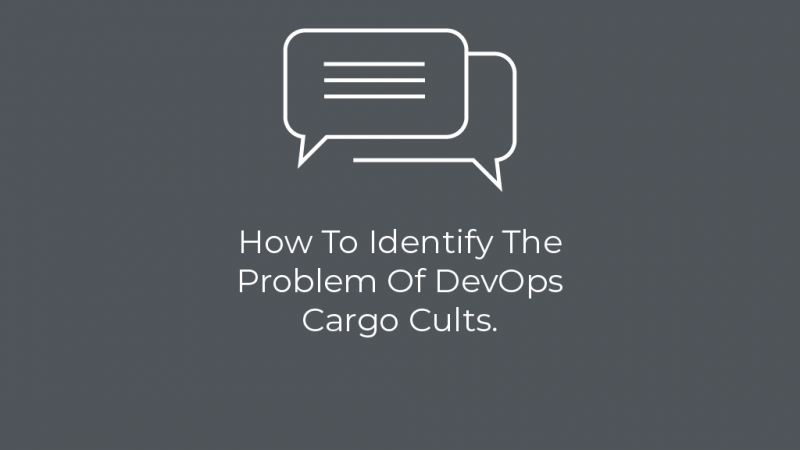How To Identify The Problem Of DevOps Cargo Cults
How is DevOps related to life-size replicas of planes made from sticks and straw? Through the phenomenon known as cargo cults. Andrew Stickland provides some much needed perspective.
- April 10, 2018

The importance of DevOps is becoming increasingly evident, as software teams wake up to the potential benefits it offers. But there’s a big problem: many organisations don’t really know what DevOps is. Instead they have an incomplete picture of what it means, and this lack of clarity eventually leads to poorly implemented solutions – some of which can actually be the opposite of what DevOps is meant to be. Over the course of three articles, I’ll be exploring the challenges that IT teams face when thinking about DevOps and how they can overcome them.
One of the major problems – and the subject of this first blog post – is the phenomenon known as the cargo cult. When a cargo cult forms within a business, it wastes time and money, and builds expectations that simply cannot be fulfilled without significant change.
Of course, before we can look at how this problem affects businesses, there’s one more pressing question we need to answer first: What is a cargo cult?
Call It And It Will Come

In the late 19th and early 20th centuries, a phenomenon known as cargo cults came into existence as colonial expansion pushed out into remoter parts of the world. The indigenous people of the colonised regions observed the colonists arriving, followed by an astonishing wealth of supporting goods. In their eyes, one thing led to the other.
These cults really took hold after World War 2. During the war, both Japan and America used South Pacific islands as military bases. The islanders watched large numbers of troops arrive and then – as if by magic – vast quantities of equipment, food, medicine and clothing, mostly air dropped or air lifted into the bases. This abundance of wealth was astonishing to people who had never before seen outsiders.
After the war, these bases were abandoned and the islanders who had shared some of the wealth were bereft of the benefits brought in by air. A cult grew out of this void, along the lines of ‘call it and it will come’.
Imitating the soldiers and sailors they had watched, they started to build crude runways and control towers and to craft imitations of headsets and goggles and march in military fashion, replicating the rituals they had seen – all in the hope of attracting back the planes with their wealth from the skies, thereby recreating the dream. Some societies even built life-size replicas of planes in the hope that sympathetic magic might help their cause.
The DevOps Cargo Cult
In a business sense, you easily see how this kind of thinking might manifest itself. By imitating some of the practices or structures of a more successful enterprise, misguided businesses might expect to gain some of the same rewards. But like the islanders who built non-functional replicas of aircraft from sticks and straw, this is a recipe for failure. Why? Because neither the problem nor solution is fully understood.
This lack of understanding then results in what’s known as the myth dream. With the original cargo cults, the myth dream characterised itself as a synthesis of indigenous and foreign elements – a fusion of the colonists’ technology and the native spiritual beliefs. They imitated the customs of the Westerners, but in the hope of appealing to the gods that were seemingly providing such endless bounty.
In an enterprise setting, the myth dream phenomenon results in leaders frequently missing the point, blindly building DevOps teams or running headlong after some element of the practice without understanding the underlying principles. They’ve probably seen the fruits of successful DevOps, and they do their best to ape the practices that apparently lead to these rewards.
As with any cargo cult, these people are well meaning, and they correctly identify some of the characteristics of the system and the results that can be achieved. But ultimately, they are misguided, and their attempts to emulate what they see results in wasted time and resources.
I’ll be looking at these poor DevOps practices in more detail in the next blog post. Follow Clearvision on Twitter, LinkedIn or Facebook to make sure you don’t miss any updates!
clearvisionwebmaster
Atlasssian expert resources
Visit our blog for expert news and articles from the Atlassian world. On our resources page you will find recorded webinars, white papers, podcasts, videos and more.
The Software Blog
Read our blog for articles offering best practice advice written by Atlassian experts, as well as the latest news concerning your software.
Software White Papers and Guides
Dive deep into Atlassian software with our white papers and guides on individual tools, partner products, services, and best practices, written by the experts.
Expert Webinars
All of our webinars are pre-recorded and available to watch on-demand. Enjoy everything from partner features to application demos and updates from Atlassian experts.















